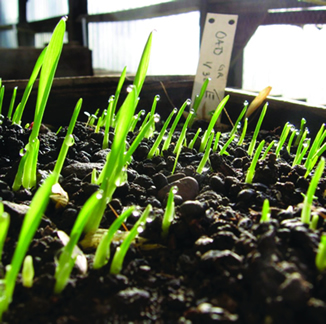Herbal Spotlight: Oats
Anyway, today we mostly look at the calorie-dense common oat and see a familiar breakfast food or a fodder crop for livestock. But Avena has so much more to offer us as a medicinal plant! The unripe grain, called "milky oats" (oat tops harvested at the stage between flowering and the hardening of the seed, when the still-soft grains release a white, milky sap when squeezed) and the green stem of the plant called "oatstraw" (harvested at the same time as the milky oats) are known to have many beneficial qualities, one of which seems particularly useful right now: as a potent yet gentle nerve tonic to help your system cope with stress. According to theherbalacademy.com “Oats are considered one of the best remedies for “feeding” the nervous system, particularly in times of stress and in the case of nervous system weakness or exhaustion associated with depression (Hoffman, 2003), overwork, or emotional trauma (Rose, 2010). Symptoms may include irritability, chronic fatigue, inability to focus, loss of libido and heart palpitations (Rose, 2010). Oatstraw infusion helps mellow the mood, ease anxiety, combat the effects of daily stress, and resolve sleeplessness…supporting sexual health and increasing libido by nourishing the endocrine system and regulating hormones (Edwards, 2000), moistening glands, and restoring nerve health (Berger, 1998). … By strengthening and soothing nerves, balancing endocrine function, and nourishing the immune system, oatstraw fosters physical, mental, and emotional strength and resilience (Berger, 1998). As the tall oat plant which sways and dances gracefully with the changing winds yet remains firmly rooted and grounded in the Earth, so too will those who take oat’s medicine.” And oldwaysherbal.com says “Oat ... is beloved as a restoring, nutritive nervine tonic (medicine whose effects build slowly over time). In women’s health we cherish oat for its properties as a mineral rejuvenator and protector against adrenal exhaustion–goodbye postpartum depression! Hello restful sleep, coping skills, and an end to feeling stretched too thin, exhausted, and sapped of vitality. ... it has a grounding, moistening effect for folks who feel burnt out, dried up, and frazzled ... the minerals your body needs for your heart, muscles, bones, and nerve transmission to work well; kidney and liver function; and it bestows a feeling of general well-being to those of us lucky enough to bask in its welcoming green glow. As is common, the tea is a gentler, more long-term builder known for its mineral-related actions, while the tincture is stronger and more known for antidepressant and nervine actions.” You can buy dried oatstraw, milky oats and even prepared tinctures from reputable herb suppliers, but you can also grow your own! Oat is a short-season, cool weather crop, so you may still have time to plant it this spring; if not, you can also plant it in the fall. The article online at oldwaysherbal.com/2014/04/22/milky-oats-tincture-whats-the-secret/ is a good guide to planting, growing, and harvesting milky oats, and has instructions for making a tincture with them, as well. ♥ top | Newsletter Home |Table of Contents| Archive
|


 The humble oat, Avena sativa, wasn't always the popular plant it is today. Thought to have first been cultivated in the Caspian basin and Caucasus foothills, oats made their way to Europe during prehistoric times, and was the last major cereal grain to be domesticated there. The Romans, who preferred barley, thought of oats as horse food, and mocked the Germanic tribes as "oat-eating barbarians." But then the oat-eaters overthrew Rome, so...
The humble oat, Avena sativa, wasn't always the popular plant it is today. Thought to have first been cultivated in the Caspian basin and Caucasus foothills, oats made their way to Europe during prehistoric times, and was the last major cereal grain to be domesticated there. The Romans, who preferred barley, thought of oats as horse food, and mocked the Germanic tribes as "oat-eating barbarians." But then the oat-eaters overthrew Rome, so...